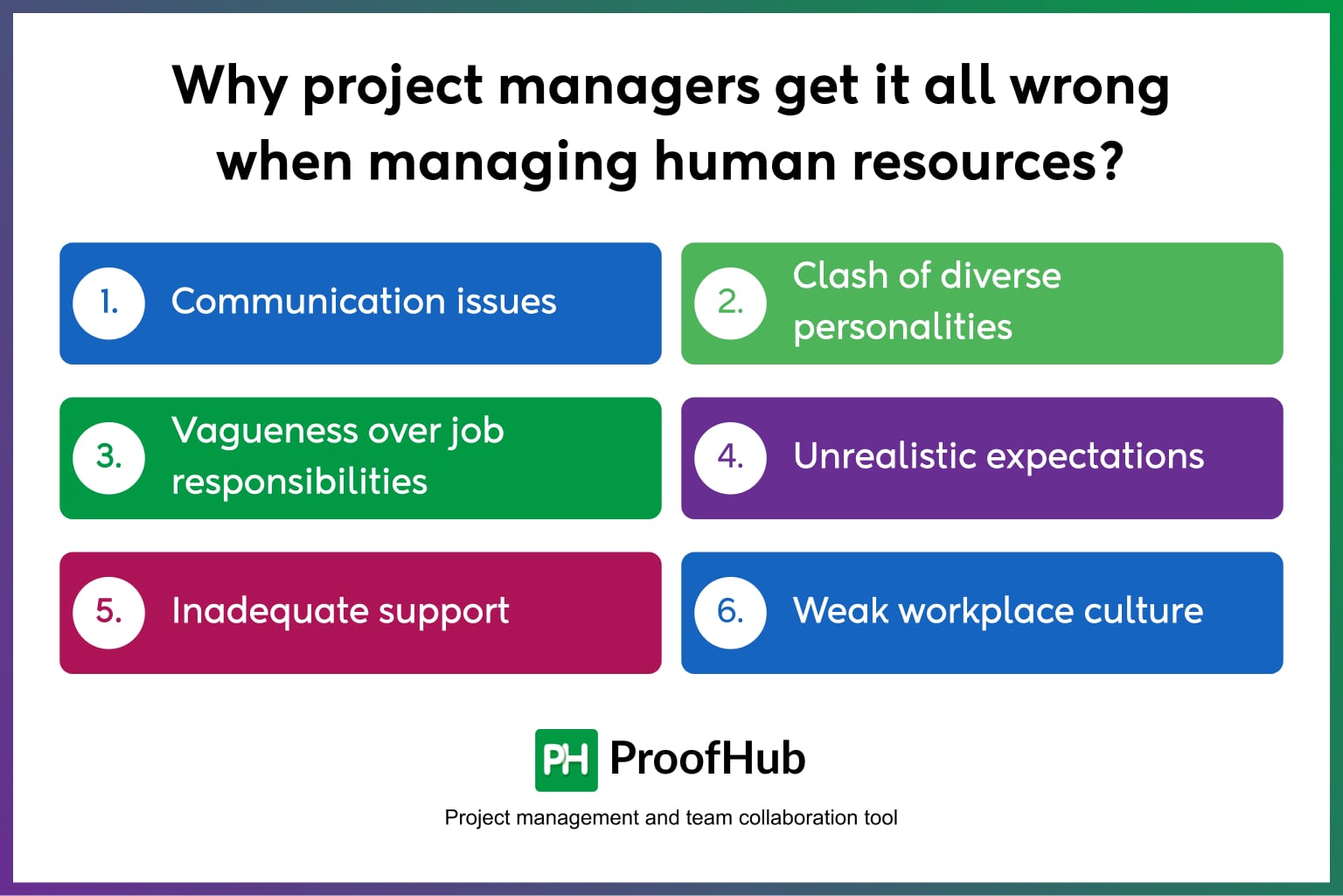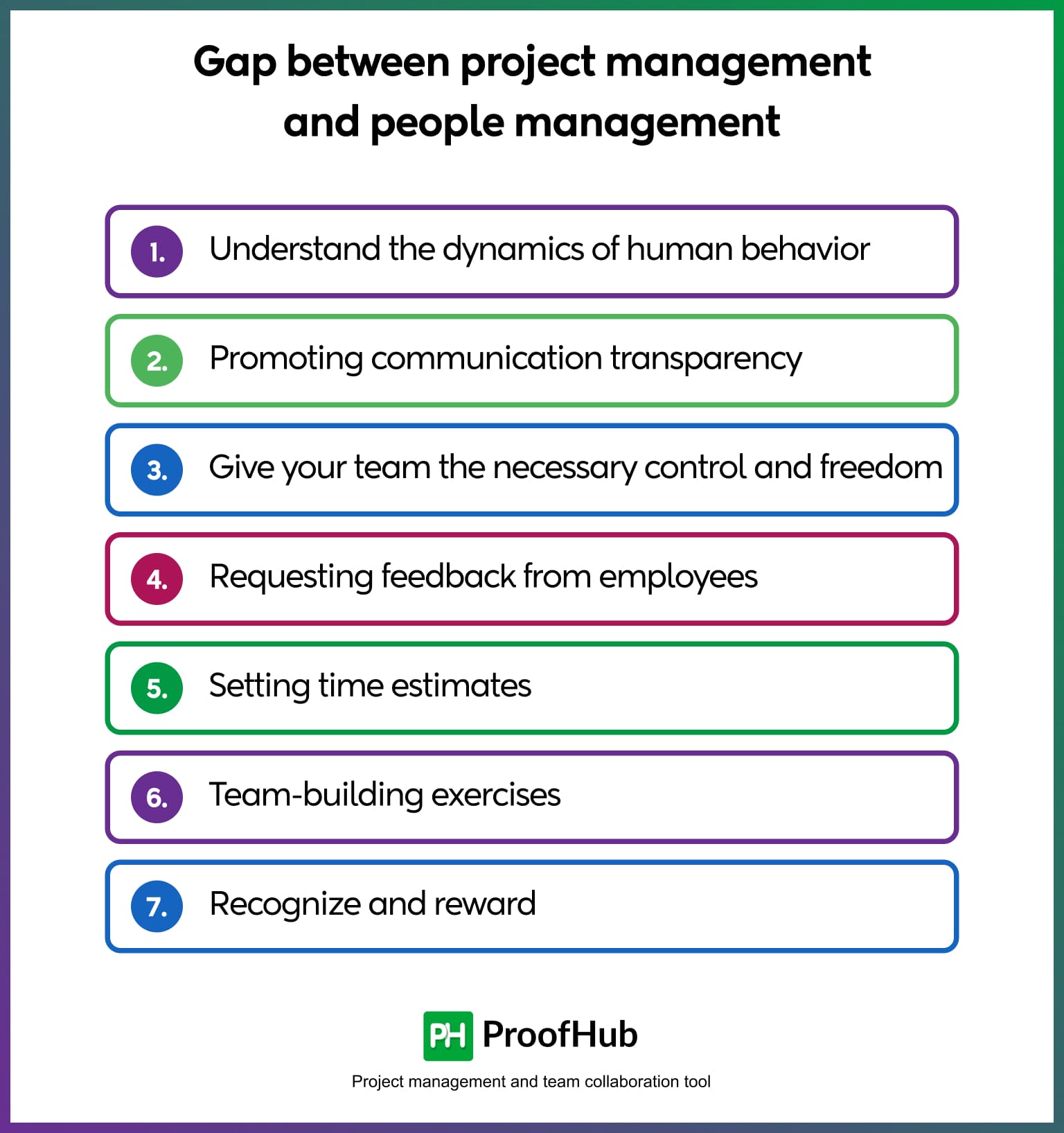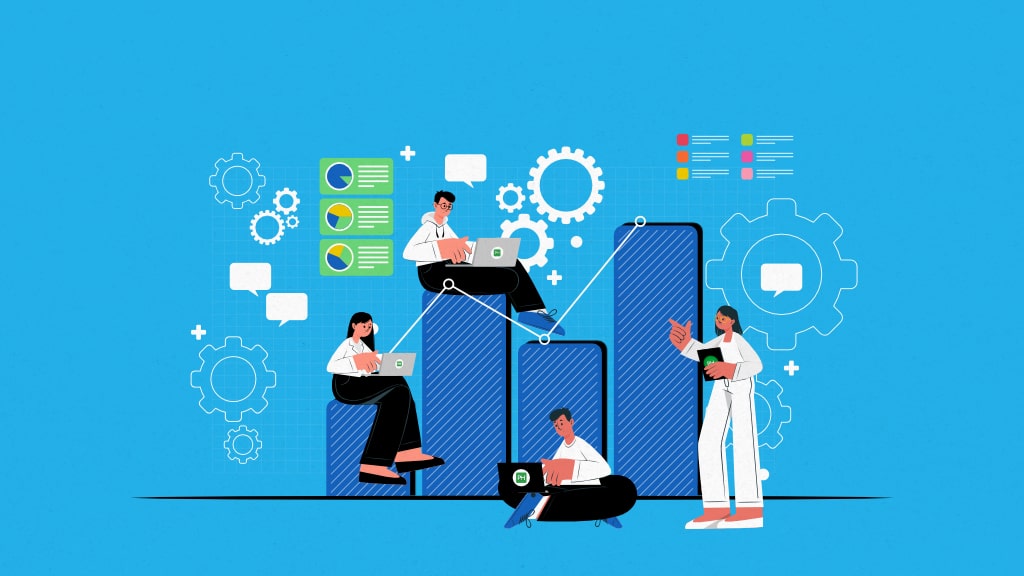Project managers are primarily responsible for delivering and completing a project on time. While a project manager requires technical skills, managing people and the team is also vital.
Some project managers are so focused on managing the technical elements of a project (time, tasks, reports, scheduling, risks, project objectives, deliverables, etc.) that they sometimes ignore the most important element—the people who work together to make the project a success.
In this article, we will understand the key differences between project and people management, what mistakes managers should avoid and how to close the gap between them.
What is more important – people management or project management?
When you ask project managers this question, they usually reply that people management is an integral part of project management and that the latter is a broad and comprehensive subject.
Now, here’s the thing. If you are among those managers who consider people management a part of project management, then you should brace yourself for more challenges during the project. Why? Simply because you are not giving enough attention to human resources.
On the other hand, if you consider people management as your foremost priority and the fulcrum around which the entire project revolves, it is likely to be on track to deliver your project with fewer or manageable issues.
As mentioned earlier, you have to prioritize people over everything else. The success of your project lies in the hands of these people, so you should ensure that the people management part is not overlooked.
What is project management?
As the term suggests, project management involves planning, managing, coordinating, controlling, and monitoring all important aspects of a project to achieve organizational objectives while meeting clients’ expectations. A project manager ensures the project is planned, executed, and delivered successfully to clients. He/she must possess strong managerial skills (risk management, communication, leadership, problem-solving, etc.).
Project management is a temporary process. Once the project is closed, the project manager’s role also ends. The focus is on organizing and simplifying complex plans and procedures. The main components of project management are as follows:
- Strategic Planning: Creating a comprehensive plan to accomplish the project, holding meetings with all project stakeholders and team members to discuss project requirements, contributions from individuals and teams, available resources, and potential risks.
- Collaboration: Issuing directions, decision-making, task assignment, and managing internal and external teams who report to you regularly. Taking feedback from team members to make well-informed decisions, utilizing skill sets, and encouraging team participation and engagement.
- Implementation: Creating plans, setting timelines for tasks and projects, streamlining work processes, and tackling challenges to ensure the project’s progress is not hampered and stays on track.
What is people management?
People management is a part of the human resource management system, but hiring competent people isn’t good enough. It’s also about how project managers and team leaders manage their skilled employees, which sets the tone for the overall organizational performance.
An effective people manager strives to train, guide, and empower employees to reach their full potential while delivering great services and value to their organization.
As Shelisa Bainbridge, leadership coach and head of human-centered delivery at Agile by Design, puts it, “People management should be reframed as team orchestration because it leads to an immediate shift in attitude, value, and impact surfaces in the managers who are responsible for the output of that team.”
The focus shifts from creating and executing plans to listening, connecting, and relating to your team members daily to help them be the best versions of themselves. This eventually leads to great results not only for individuals and teams but also for the entire organization.
People management revolves around:
- Understanding People: Good people management requires managers to clearly understand all the people who are part of the project. To achieve this goal, managers should hold one-on-one meetings with them to get a fair idea about their personal and professional goals, inspiring factors, and career interests. An empathetic, people-first approach will enable managers to judge where certain employees fit, and how their skills can be maximized for optimal output.
- Communication: Seamless communication between team members is a prerequisite for the synchronization of all team members’ efforts. Therefore, managers must establish appropriate communication channels to ensure the right information is conveyed to the right recipient(s) in time. Actively listening to employees’ grievances allows managers to address their concerns and provide feedback proactively.
- Collaboration: Establishing a strong people management system is about bringing all team members collectively on a single platform. Using a powerful project management and team collaboration tool like ProofHub enables team members to understand tasks and roles assigned to them clearly. With the help of these collaboration tools, employees can clearly understand the respective roles they’re supposed to play to accomplish the vision and mission of the business.
- Knowledge and Development: People management in companies also includes analyzing employees’ knowledge and skills. This process allows organizations to identify each person’s strengths and weaknesses. Strategies are formulated to improve their current skill, directly impacting their productivity and efficiency.
What is the difference between project management and people management?
The main difference between project and people management is their purpose and focus. Project management primarily focuses on planning, executing, and completing a project, whereas people management is focused on leading and supporting individuals or teams within an organization.
Here is a table for comparison:
| Aspect | Project Management | People Management |
| Key objective | Delivering a project | Build strong, high-performing teams |
| Timeframe | Temporary (until project completion) | Ongoing and long-term |
| Primary focus | Tasks and deadlines | Developing and managing people |
| Skills required | Technical and organizational | Leadership and emotional intelligence |
Why do project managers get it all wrong when managing human resources?
Over the past couple of decades, project management has evolved from a simple process to a highly technical one. The use and reliance on the latest tools and technology have increased manifold, bringing efficiency and accuracy to work processes.
Even though technological advances have helped project managers deliver more projects successfully, many projects still fail despite having all the tools and strategies at their disposal.
Have you ever wondered why such projects fail to cross the finish line? It’s mainly due to poor human resource management by project managers. Since project management is teamwork, even a small issue can metamorphose into a big hurdle that can impact the project’s success possibilities and demoralize the team working on it.
Let’s look at some main reasons project managers sometimes struggle with good project resource management.

- Communication Issues—Poor communication has always been one of the main reasons behind fueling misunderstanding, suspicion, and intra-team conflicts. As a project manager, you must make sure that all team members are in the loop whenever crucial information is circulated. Fewer, irregular interactions with team members and failing to determine the use of the right communication channels result in poor people management.
- Clash of Diverse Personalities—Every team has people from different cultural backgrounds, ethnicities, genders, races, etc. Differences in perspectives and behaviors can give rise to a clash of different personalities in the workplace.
- Vagueness Over Job Responsibilities—When project managers fail to assign the right tasks to the right people, it results in poor work performance and uncertainty over the task distribution. This also leads to underutilization of manpower, which further adds to their frustration.
- Unrealistic Expectations- Another common mistake. In order to get the maximum productivity out of team members, some project managers push their team members too far by setting unrealistic expectations at work. This creates a lot of unnecessary pressure on employees to deliver results that are beyond their capabilities.
- Inadequate Support —Managers cannot make all decisions themselves. Sometimes, they have to get approval from senior management or the business owner to proceed with the project. Slow decision-making may hamper the team’s overall progress.
- Weak Workplace Culture- When team members feel like they’re not an integral part of the workplace, they could lose interest and zeal in their work. They do not feel like a part of a larger group, and their productivity declines, which can also have a ripple effect on other team members.
Why is people management crucial for the successful project delivery?
Any experienced and skilled project manager knows that working with disorganized, demoralized, and poorly managed teams can devastate various aspects of your business.
On the other hand, working with a productive team that is motivated and determined generally results in improved productivity and efficiency, as well as giving your business a crucial competitive advantage over its competitors.
Let’s examine how proper people management benefits organizations in more ways than one.

Better intra-team chemistry
High-performance teams have one trait in common—they gel well with each other despite their different personalities and perspectives. Team members share cordial relationships, which shows in improved work performance due to the collective efforts of the entire team. Good teams celebrate achievements and milestones together, learn from mistakes, and work together to overcome different challenges.
Improved productivity
A bunch of happy people tend to be more productive than those who’re always fretting and whining. Right? Having properly trained and well-guided employees who collaborate with other team members to achieve common project and organizational goals is the most valuable asset any organization would yearn to have. Unsurprisingly, smartly managed employees are the most productive of the lot.
Helps businesses have the upper hand in the marketplace
Building a motivated workforce gives businesses a strong upper hand in the marketplace. Since small businesses have limited resources compared to their large-scale, well-equipped counterparts, guiding a smaller pool of human resources to utilize their maximum potential is crucial.
Improved work environment
Proper human resource management tends to improve the work environment within the organization significantly. Implementing positive practices helps employees develop an empathic attitude toward each other, shows them how valuable their resources are, and demonstrates how their contributions assist in achieving organizational goals.
Workforce development
Investing in training employees and empowering them with the latest technology will improve their performance, which will benefit the organization. Project managers must introduce effective training programs to maximize their skills to deliver desired results.
Attracting and retaining top talent
Good people management invariably helps companies attract and retain top talent. Employees who have been loyal to their organization for years find a congenial environment, staff benefits, and good training the main reasons to continue rendering services. An improved employee retention rate strengthens the company’s profile and reduces high turnover costs.
Business goals alignment
Good people management makes employees understand the business goals through team meetings, feedback sessions, internal events, communication actions, etc. The alignment of organizational and individual goals motivates people to put their best foot forward to achieve business goals.
Bridging the gap between project management and people management
It’s no secret that people management is probably the most important soft leadership skill that any project manager worth his salt should have. Managing manpower efficiently is the first step towards achieving bigger organizational goals.
The point is, how can project managers narrow the gap between project management and people management? Here are a few tips to help you sync these specialties for better outcomes.

Understand the dynamics of human behavior
People management is incomplete without understanding the dynamics of human behaviour. As a project manager, you need to understand that different people behave differently in a particular situation. This is mainly because human behavior is influenced by a combination of various factors, such as family, environment, beliefs, culture, ideology, etc.
Expecting the same answers, behaviors, and results from everyone would be wrong. Learning the behavior of every individual would help project managers better understand their team members.
Promoting communication transparency
Good communication is the core requirement of any successful project team or project. Maintaining transparency in communication is the key to promoting mutual trust amongst all those involved in the project. Using the right communication channels to convey different types of information plays a crucial part in ensuring the seamless flow of communication across the organization.
Give your team the necessary control and freedom
Even though project managers are primarily responsible for overseeing the project throughout its lifespan, it’s important to give your team a sense of ownership. Displaying an authoritarian attitude will make you look more like a ringmaster than a collaborator par excellence.
Trust your team members and their skills to carry out the tasks they are assigned. When you give your team members a sense of freedom and flexibility to do certain things their way, they will feel more confident in their abilities and your leadership.
Requesting feedback from employees
Sometimes, managers keep a close eye on employees who are primarily responsible for creating conflicts and tensions in the workplace. It’s crucial for managers to nip problems in the bud before they become bigger problems. So, you should request feedback from your team members to learn about any impediments they may be facing at work.
You can implement some of their feasible suggestions to show you’re an active listener who understands their perspective. You can also seek help from your organization’s HR department to find a solution to their problem.
Setting time estimates
When assigning tasks to individuals or groups, project managers should set time estimates so that assignees have a fair idea of by what date and within what timeframe they are expected to complete the work. This will also help team members set their own pace for specific tasks.
When evaluating employees’ performance, managers can easily determine how many tasks were completed by set due dates and how many tasks were delayed and completed beyond due dates. Setting time estimates also promotes job accountability and responsibility among employees.
Team-building exercises
Team-building exercises play a vital role in strengthening the bond between all team members by helping them understand each other—how each person thinks, reacts to a specific situation, and solves problems. Such exercises not only help relieve the work-related stress of employees but also help them lift their falling energy, motivation, and morale.
Rather than organizing random team-building activities, team-building should be a continuous process that aims to improve employees’ particular skills and keep team conflicts to a minimum. Before choosing a team-building exercise, assess whether your team is facing specific challenges.
For example, does your team need to get to know each other better, or are some team members not on the same page?
“According to new research of 600 US businesses with 50-500 employees, 63.3% say retaining employees is actually harder than hiring them.”
- Recognize and reward
Recognized employees are known to be the most satisfied employees. Nothing makes employees happier than being praised and rewarded for their hard work. This further motivates them to work harder because they know their efforts would not go unnoticed/ignored by the senior management. Although cash reward remains the most preferred form of reward, team leaders can also use promotions, email appreciation, trips, certificates, and gifts to recognize well-performing employees.
You can consider surveying your staff to assess their expectations from recognition. You can put up a list of options and ask them to vote or seek their suggestions. Employees’ input will help you determine what recognition program will deliver value to your team and your organization.
The final thought
People are your most valuable resource, and great leaders know how to get the best out of their teams to improve the overall quality of projects. Properly managed people will undoubtedly yield better results than those not given due weightage by their organizations.
This article will help project managers and team leaders pay more attention to their workforce, so they don’t feel undervalued, unrecognized, and overlooked. Take care of your employees and they will take care of your business, as simple as that!

